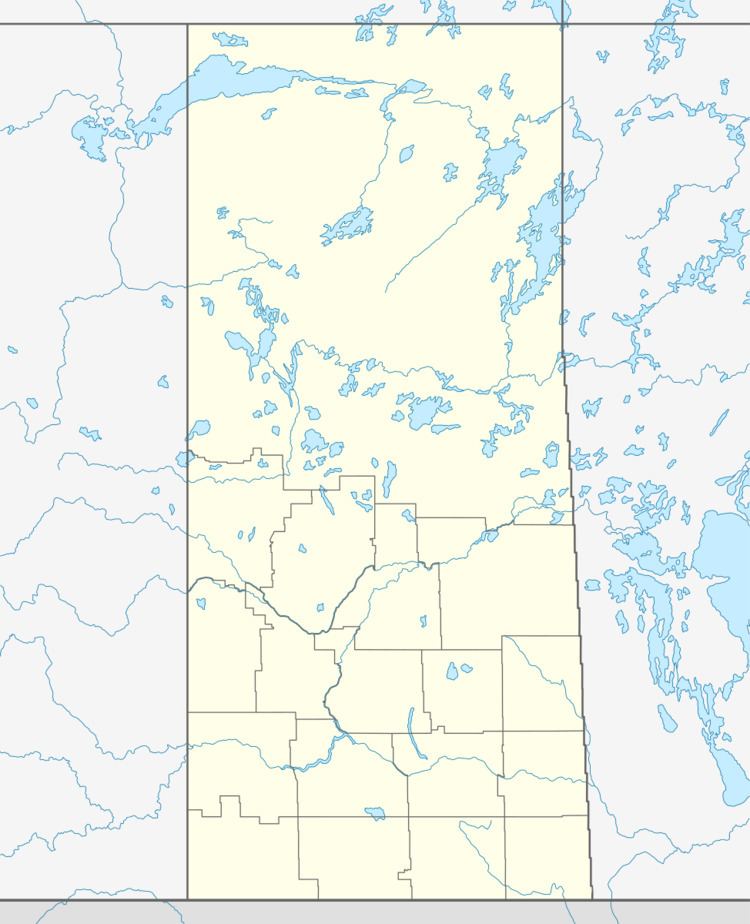Eastend is a town in southwest Saskatchewan, Canada. It is situated approximately 55 kilometres (34 mi) north from the Montana border and 85 kilometres (53 mi) from the Alberta border.
The town is best known for the nearby discovery of a Tyrannosaurus rex skeleton nicknamed "Scotty" in 1994. The town has used the discovery of this fossil as the main centrepiece in the construction of a museum called the T. rex Discovery Centre, which opened on May 30, 2000. The centre is operated by the Royal Saskatchewan Museum, and contains the RSM Fossil Research Station. A former resident of Eastend is the writer Wallace Stegner, who lived in the town between 1917 and 1921 and featured it as the village Whitemud in his book Wolf Willow.
Eastend is located south-east of the Cypress Hills, east from Ravenscrag Butte and south from Anxiety Butte. It lies at an elevation of 915 meters (3,002 ft), in the valley of the Frenchman River. The Eastend Reservoir was built upstream from the community.
The Eastend Formation, a stratigraphical unit of the Western Canadian Sedimentary Basin was named for the town and was first defined in outcrops close to the settlement.
Saskatchewan Highway 13 and highway 614 intersect in Eastend. The Canadian Pacific Railway tracks also pass through the town. The Saskatchewan Transportation Company provides intercity passenger and parcel express service to Eastend.
T.rex Discovery Centre is a world class facility to house the fossil record of the Eastend area started many years before the discovery of "Scotty" the T.Rex in 1994.Big Muddy Badlands is a series of badlands in southern Saskatchewan and northern Montana along Big Muddy Creek. They are found in the Big Muddy Valley, a cleft of erosion and sandstone along Big Muddy Creek. The valley is 55 kilometers (34 mi) long, 3.2 kilometers (2.0 mi) wide and 160 meters (520 ft) deep. The valley was formed when it was part of an ancient glacial meltwater channel that carried great quantities of water southeastward during the last ice age.Cypress Hills Interprovincial Park straddles the southern Alberta-Saskatchewan border, located north-west of Robsart. It is Canada's first and only interprovincial park.Cypress Hills Vineyard & Winery is open by appointment only from Christmas until May 14.Fort Walsh is part of the Cypress Hills Interprovincial Park. As a National Historic Site of Canada the area possesses National Historical Significance. It was established as a North-West Mounted Police (NWMP) fort after and at the location of the Cypress Hills Massacre.Grasslands National Park represents the Prairie Grasslands natural region, protecting one of the nation's few remaining areas of undisturbed dry mixed-grass/shortgrass prairie grassland. The park is located in the WWF-defined Northern short grasslands ecoregion, which spans across much of Southern Saskatchewan, Southern Alberta, and the northern Great Plains states in the United States.The Great Sandhills is a sand dune rising 50 feet (15 m) above the ground and covering 1,900 square kilometers. Native prairie grass helps keep the sand together.Robsart Art Works is open July 1 to August 28, 2010 from 1 to 4 p.m. and by appointment and features Saskatchewan artists and photographers of old buildings and towns throughout Saskatchewan.John W. Bascom (1869–1948), frontier lawman, rancher, rodeo pioneer, rodeo stock contractor, Hall of Fame inducteeMelvin Bascom (1903–1987), rodeo pioneer and champion, rancher, Hall of Fame inducteeRaymond Bascom (1901–1943), rodeo pioneer, champion chariot racer, rancher, race horse trainer, Hall of Fame inducteeSharon Butala, Canadian author who resides on a ranch outside of EastendGeorge Haddad (1918–2010), world-renowned pianist, born and raised in EastendWallace Stegner, Pulitzer Prize–winning writer and environmentalist who lived in Eastend from 1917 and 1921Clark Stork (1979–present), voice of the Humboldt BroncosSéan Virgo, poet and novelist who was born in Malta and has lived in South Africa, Malaya, Ireland, and the UK; his work has won various national and international awards
